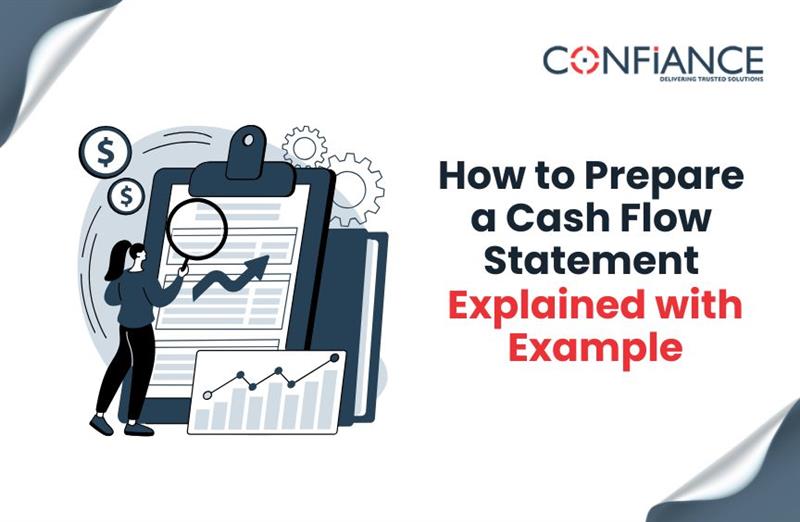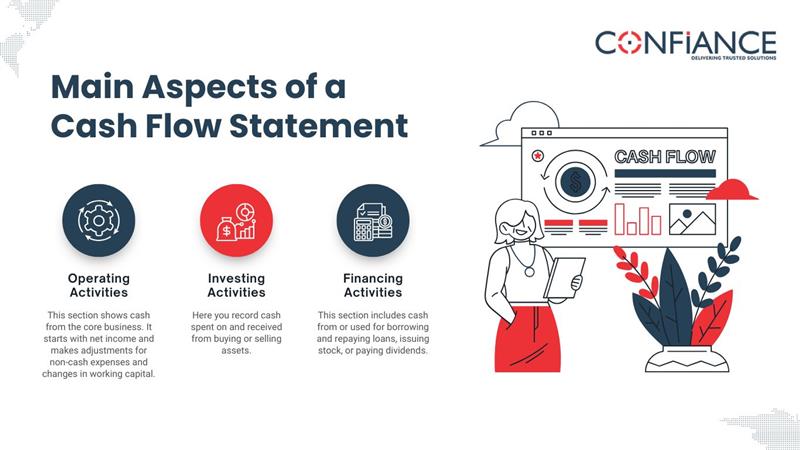
How to Prepare a Cash Flow Statement – Explained with Example
A cash flow statement tracks all cash inflows and outflows to show how money moves in and out of a business. It tracks cash from operations, investing, and financing. It helps in controlling short term spending and making a long term plan. In this guide, we show how to prepare a cash flow statement step by step. Creating a cash flow statement becomes simple when you follow a structured example, making the process easy to understand.
What Is a Cash Flow Statement?
A cash flow statement is a report/statement showing how much money a business receives and how much it pays out during a set period. It shows three main types of activities: operations, investing, and financing. Unlike the income statement, which includes items like depreciation, this report shows only real cash activity.
It helps owners, managers, and investors see if the business can pay bills, repay debt, and support growth. Lenders also use it to check if a business is stable before giving credit.
Why Is the Cash Flow Statement Important?
It gives a complete view of a business’s liquidity. Profit does not always mean the business has cash. A company can show profit but still struggle to pay bills. That’s why this report matters.
A thorough and accurate statement can assist you:
- Spot cash gaps before they cause problems
- Track where money goes
- Check if your business can afford new costs
- Show financial health to lenders and investors
- If you spot negative cash flow early, you can fix it before it affects business operations.

Main Aspects of a Cash Flow Statement
Each section of the cash flow statement highlights different inflows and outflows of cash, helping to identify where money comes from and where it goes.
1. Operating Activities
This section shows cash from the core business. It starts with net income and makes adjustments for non-cash expenses and changes in working capital.
Common items:
- Net income
- Depreciation and amortization
- Changes in accounts receivable
- Changes in inventory
- Changes in accounts payable
2. Investing Activities
This part shows cash inflow from sales of assets and cash outflow from purchases of assets or investments.
Common items:
- Purchase of equipment
- Sale of equipment
- Investments in other businesses
- Proceeds from asset sales
3. Financing Activities
This section records the flow from financing activities, including cash from borrowing, loan payments, or issuing shares.
Common items:
- Loan proceeds
- Loan repayments
- Issuance of stock
- Dividend payments
Methods of Preparing a Cash Flow Statement
There are two ways to create:
- Direct method and 2. Indirect method.
Direct Method
This method lists actual cash received and paid. It is simple but requires detailed records.
Example of direct method:
- Cash received from customers: $90,000
- Cash paid to suppliers: $50,000
- Cash paid for wages: $20,000
- Cash paid for rent: $5,000
Net cash from operations = $90,000 - $75,000 = $15,000
Indirect Method
This is even common and begins with net income. Next, it accounts for non-cash expenses and changes in working capital.
Steps:
- Start with net income
- Add non-cash expenses
- Adjust for changes in current assets and liabilities
This method is easier while using accounting software. Most of the data is already available from the balance sheet and income statement.
Preparing a Cash Flow Statement with Example
Let’s go through the process using the indirect method. We’ll use a simple example to prepare a cash flow statement for a small business.
Assume these figures for the year:
- Net income: $25,000
- Depreciation: $5,000
- Accounts receivable increased by $3,000
- Inventory decreased by $2,000
- Accounts payable increased by $1,500
- Bought new equipment: $8,000
- Took a loan: $10,000
- Paid dividends: $2,000
Step 1: Operating Activities
Start with net income:
Net income = $25,000
Add non-cash expenses:
Depreciation = $5,000
Adjust for changes in working capital:
- Accounts receivable increase = subtract $3,000
- Inventory decrease = add $2,000
- Accounts payable increase = add $1,500
Net cash from operations =
$25,000 + $5,000 - $3,000 + $2,000 + $1,500 = $30,500
This total represents the net cash flow from operating activities for the period.
Step 2: Investing Activities
This section reflects the cash flow from investing activities like buying equipment or selling assets.
Only one transaction here:
- Bought equipment = subtract $8,000
Net cash from investing = -$8,000
Step 3: Financing Activities
This part shows the cash flow from financing activities, such as borrowing, repaying loans, or paying dividends.
- Took out a loan = add $10,000
- Paid dividends = subtract $2,000
Net cash from financing = $8,000
Step 4: Total Cash Flow
Now combine all sections:
- Cash from operations = $30,500
- Cash from investing = -$8,000
- Cash from financing = $8,000
Net increase in cash =
$30,500 minus $8,000 plus $8,000 equals $30,500
If starting cash was $10,000, the ending cash is:
Ending cash = $10,000 plus $30,500 = $40,500
Example:
Here is how it looks:
Cash Flow Statement for ABC Company (Year Ending December 31)
Operating Activities
Net income: $25,000
Add: Depreciation: $5,000
Less: Increase in accounts receivable: -$3,000
Add: Decrease in inventory: $2,000
Add: Increase in accounts payable: $1,500
Net cash from operations: $30,500
Investing Activities
Purchase of equipment: -$8,000
Net cash used in investing: -$8,000
Financing Activities
Money received from loan: $10,000
Dividends paid: $2,000
Net cash from financing: $8,000
Net increase in cash: $30,500
Cash at start of year: $10,000
Cash at end of year: $40,500
Tips for Preparing a Cash Flow Statement
- Use accounting software if possible. Most programs generate it automatically.
- Keep good records of all cash transactions.
- Reconcile it with your income statement and balance sheet to ensure all financial statements are consistent and accurate.
- Prepare it regularly to avoid surprises.
Note: You can also use cash flow statement templates to simplify the process and ensure you include every required section.
A clear statement of cash activity supports good decision making and shows how your business is managing funds. It helps you avoid shortfalls, plan spending, and prove financial strength. Whether you use the direct or indirect method, what matters most is keeping it accurate and consistent.
Use this guide and example to prepare your own statement. Doing it right keeps your business ready for whatever comes next. At Confiance, we deal with cash flow management for businesses of all types. Our accounting services serve best for dealing with the business cash flow.
FAQs
How do you prepare a cash flow statement step by step?
Start with the opening cash balance. Include or remove cash flows from operating, investing, and financing activities. Finish with the ending cash balance.
What method is used in a basic cash flow statement example?
Most examples use the indirect method, which starts with net income and adjusts for non-cash items and working capital.
How is the ending cash balance calculated in a cash flow statement?
Add the net cash change to the opening cash balance. The result is the ending cash shown at the bottom of the statement.
What does a sample cash flow statement include?
It includes totals for each section, adjustments for non-cash items, and a final calculation that matches the change in cash.
